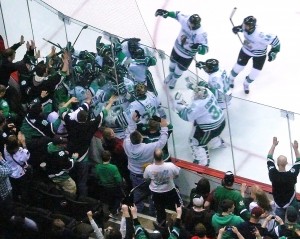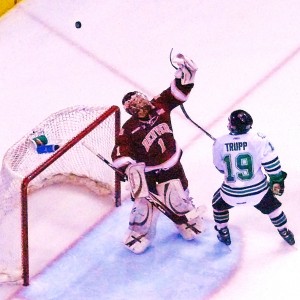WCHA’s 1-2 in Green Bay, UMD goes East
By John Gilbert
Anyone who witnessed the emotionally charged battle between North Dakota and Denver in the WCHA Final Five tournament at Saint Paul’s Xcel Energy Center might think it would be great to have a rematch between the league’s No. 1 and 2 teams. With the NCAA Frozen Four set for Xcel, that might seem feasible.
Instead, if it’s going to happen, it will be in Green Bay, Wis., in the Midwest Regional. North Dakota (30-8-3) will face Rensselaer (20-12-5) and Denver (24-11-5) plays Western Michigan (19-12-10) on Saturday in Green Bay, with those winners colliding on Sunday to grab one of the four slots in the Frozen Four. After North Dakota claimed the WCHA league title with Denver runner-up, then North Dakota beat Denver 3-2 in two overtimes in the WCHA Final Five championship game, it seemed as though those two teams might be separated into different regions, with a chance to both reach Saint Paul again.
“First, all 16 teams that have gotten to this point are good,” said Denver coach George Gwozdecky. “We have a guy on our staff who follows the Pairwise very closely, and he laid out the way he thought the NCAA would pair the teams according to record, and he was right on. So it wasn’t really a surprise to us.”
North Dakota, which ranks No. 2 in the nation behind only Yale, has been bolstered recently by the return of captain and defenseman Chay Genoway, and winger Danny Kristo made his return at the Final Five, scoring the first goal in both the 4-3 semifinal victory over Colorado College and the 3-2 victory over Denver. Now the Sioux regain the services of Jason Gregoire.
Four of the five WCHA teams to make the tournament are bunched into two regionals, with the West Region in St. Louis seemingly the toughest, with defending NCAA champ Boston College (30-7-1) facing Colorado College (22-18-3), after Nebraska-Omaha (21-15-2) taking on Michigan (26-10-4) in a Friday-Saturday regional. WCHA boosters might anticipate a CC-UNO final, but that would require two upsets, based on the 1-2 seeding of BC and Michigan. Nationally, BC ranks No. 3 and Michigan N. 5, while Omaha is No. 12 and CC No. 14.
The national rankings show: 1. Yale, 2. North Dakota, 3. Boston College, 4. Miami, 5. Michigan, 6. Merrimack, 7. Denver, 8. Union, 9. UMD, 10. Western Michigan, 11. Notre Dame, 12. Nebraska-Omaha, 13. New Hampshire, 14. Colorado College, 15. RPI, 16. Air Force. The NCAA selection committee followed those strict Pairwise guidelines, No. 1 vs. 16, 2 vs. 15, and so forth, placing each of the top four teams as a top seed in each regional. That form also allowed each regional to have one team from the 5-8, one from 9-12, and one from 13-16. It fit together well enough that it superceded other less-strict criteria.
It also succeeded in avoiding having any of the five WCHA teams, four CCHA teams, or three teams from Hockey East and the ECAC from facing each other in the first game, but it was impossible to avoid those intraleague matchups in the quarterfinal games. “With five teams in the tournament, there had to be more than one team somewhere,” Gwozdecky said.
With the four lumped into two regions, UMD is the fifth WCHA entry, and is going to the East Region in Bridgeport, Conn., where it will play Union, while Yale meets Air Force in the second game Friday. By tradition, that looks like a favorable set-up for the Bulldogs. But there are other Bulldogs in that field, and the Yale Bulldogs at not only the top seed in the regional, but rank No. 1 in the nation at 27-6-1. Ironically, Yale lost the ECAC league championship by one point to Union (26-9-4), so Union makes its first NCAA appearance as ECAC champion but a No. 2 seed in the regional, against UMD (22-10-6).
There are no WCHA teams in the Northeast Regional at Manchester, N.H., which, like the Midwest, is Saturday-Sunday. With two CCHA and two Hockey East entries, Miami of Ohio (23-9-6) is top seed and faces host New Hampshire (21-10-6), after Merrimack (25-9-4) plays Notre Dame (23-13-5),
Transportation costs and potential crowd attractions were less important. Otherwise, while it was logical to send North Dakota by bus down Hwy. 2 and on to Green Bay as top seed, it also made sense to send Minnesota-Duluth by bus to Green Bay, because the Bulldogs might also bring a strong fan base. That way, UMD and Denver might have switched spots, but Denver is second-seed at Green Bay, and UMD is a third, so they weren’t eminently swapable.
Similarly, Hockey East champ Boston College would be logical to be at the Northeast Regional, but New Hampshire already was the host school there, and the host school is guaranteed that if it makes the field, it will be at that site. As a No. 4 seed in that region, UNH would have had to be paired against fellow-Hockey East foe BC, in the first game, the sort of intraleague first-round match-up the NCAA successfully avoided.
Like the WCHA at Green Bay, the ECAC has its top two league teams at the same site. In national ratings, Union is No. 8 and UMD No. 9, so their game is strictly according to form, and the Bulldogs will be wearing road maroons as visitor. Air Force (20-11-6) is the nation’s No. 16 seed, with an at-large entry to the NCAA for winning its league playoff. If UMD and its boosters figure they will show WCHA supremacy by sweeping aside Union, the Bulldogs should be aware that Union came West and beat Minnesota 3-2 in overtime during a holiday tournament, before losing 3-1 to Bemidji State. The Dutchmen also beat Alaska-Anchorage 4-3, and beat Yale 3-2 during the season.
Since losing to Minnesota, Union went 14-1-1 the rest of the regular season. They had to await and at-large bid after following up their one-point league title by being upset by Colgate in a three-game playoff series. Union is led by Kelly Zajac of Winnipeg, brother of former North Dakota star Travis Zajac, now playing for New Jersey in the NHL, and goaltender Keith Kinkaid, of Farmingville, N.Y., was ECAC galie of the year with a 1.98 goals-against and .920 save percentage.
Comments
Tell me what you're thinking...
and oh, if you want a pic to show with your comment, go get a gravatar!




 John Gilbert is a lifetime Minnesotan and career journalist, specializing in cars and sports during and since spending 30 years at the Minneapolis Tribune, now the Star Tribune. More recently, he has continued translating the high-tech world of autos and sharing his passionate insights as a freelance writer/photographer/broadcaster. A member of the prestigious North American Car and Truck of the Year jury since 1993. John can be heard Monday-Friday from 9-11am on 610 KDAL(www.kdal610.com) on the "John Gilbert Show," and writes a column in the Duluth Reader.
John Gilbert is a lifetime Minnesotan and career journalist, specializing in cars and sports during and since spending 30 years at the Minneapolis Tribune, now the Star Tribune. More recently, he has continued translating the high-tech world of autos and sharing his passionate insights as a freelance writer/photographer/broadcaster. A member of the prestigious North American Car and Truck of the Year jury since 1993. John can be heard Monday-Friday from 9-11am on 610 KDAL(www.kdal610.com) on the "John Gilbert Show," and writes a column in the Duluth Reader.